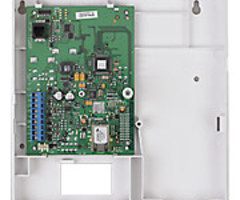Do I Need to Add a Resistor to the Honeywell 7847i?
No, in most cases, you do not need to add a resistor to the Honeywell 7847i. Like most AlarmNet communicators for Honeywell Security Systems, no resistor is required when setting up the Honeywell 7847i in ECP Mode. The module can connect with most VISTA Systems using a 4-wire connection.

The Honeywell 7847i is an internet communicator for a Honeywell VISTA Security System. By adding this module to a VISTA System and activating it for monitoring service, the VISTA System will be able to communicate with the Resideo AlarmNet Servers. AlarmNet can then forward any incoming system events to Total Connect 2.0 and/or a central monitoring station, depending on the user's alarm monitoring plan. This is an essential component of alarm monitoring service. A VISTA user will typically purchase a Honeywell 7847i if they want to set their system up with internet monitoring. Internet monitoring is usually less expensive than cellular monitoring, but it is also less reliable.
In an effort to make their communicators compatible with as many different systems as possible, AlarmNet and Honeywell built this device with the capability of operating in different modes. ECP Mode is used with compatible panels and provides the best and most complete information when reporting panel signals. In this mode, the communicator connects to the panel's keypad bus and is able to send all panel communication to the monitoring station (where applicable) in Contact ID format. This format is capable of providing very detailed information about any events that are reported. ECP Mode is supported on all newer VISTA panels, including the VISTA-10P, VISTA-15P, VISTA-20P, VISTA-21iPLTE, and the VISTA TURBO panels. No resistor is required when the Honeywell 7847i is used in ECP Mode.
For older VISTA panels, and for panels manufactured by other companies, the 7847i supports Zone Mode. In Zone Mode, the communicator has one or more inputs connected to it from the panel being monitored. These inputs can come from programmable outputs on the system, similar to a programmable relay, or from something as simple as the panel's bell output. When in Zone Mode, a resistor may be required in order for the communicator to respond properly, and to help supervise the connection between the communicator and the alarm panel. For more information on using the 7847i in Zone Mode, check out the Installation Instructions. The 7847i can have up to six (6) zone input triggers. One of these inputs can be used as a key switch input, so that the 7847i can be armed and disarmed. In this way, it is possible to use the communicator as a simple stand-alone alarm panel/communicator all-in-one. In this scenario, End of Line Resistors (EOLR) would normally be used.
Usually, resistors are added to hardwired zones for supervision purposes. When an end of line resistor (EOLR) is properly connected to a wired zone on a panel, the system recognizes that the zone is set up correctly and is intact. In almost all cases, the EOLR will go at the last sensor in the line for the zone. The resistor will be wired in Series for Normally Closed (NC), or in Parallel for Normally Open (NO). If a sensor is physically cut from the line, then the system will lose contact with the resistor. This is how the system can recognize that the zone has been tampered with. The system will then display a fault or a trouble condition to let the user know to fix the problem. If the wired zone is not actively being used, then the EOLR can simply be placed at the zone terminals. In some panels this is a requirement. For others, it is just good practice. It will prevent the EOLR from being lost in case the zone will be added to the system in the future.
Some users think that since the Honeywell 7847i is wired to the panel, it must also use a resistor, just like a wired zone. But that is not the case. For the most part, communicator modules connected with a VISTA System do not require resistors. These modules can simply be connected using a 4-wire connection at the panel's ECP bus, without the use of any resistors. You don't necessarily need to worry about the Honeywell 7847i or its ethernet cable being cut from the panel, because the system will trigger a trouble condition due to its loss of connectivity with AlarmNet. Additionally, an intruder would normally need to access the Honeywell 7847i unit and/or your router to cause any disruption. With a proper set up, this should be impossible without triggering an intrusion zone on your alarm system.
While no resistors are required for the Honeywell 7847i, you must still make sure that the module is properly wired to your VISTA Panel. The 4-wire connection from the Honeywell 7847i will go to different locations on the panel's ECP bus, depending on which type of VISTA Panel you are using. We recommend checking this FAQ for VISTA P-Series Systems, or this FAQ for VISTA TURBO Systems. Either way, no resistor is needed for the setup.
Did you find this answer useful?
We offer alarm monitoring as low as $10 / month
Click Here to Learn MoreRelated Products

Related Categories
- Answered
